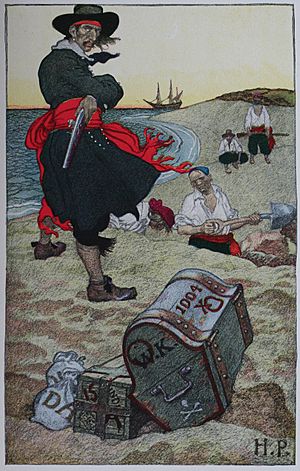Buried treasure facts for kids

A buried treasure is a big part of exciting stories about pirates and Old West outlaws. People often imagine that these characters hid their stolen riches in secret spots. They planned to come back for them later, sometimes using treasure maps to find the way.
Contents
Pirate Treasure Stories
In real life, pirates rarely buried their treasure. The most famous pirate known to have buried treasure was William Kidd. He is thought to have hidden some of his wealth on Long Island. This was before he sailed into New York City.
Kidd was first hired by England as a privateer. This meant he was allowed to attack enemy ships. But he started acting like a real pirate. He hoped his buried treasure would help him avoid punishment. However, his plan did not work. Kidd was later hanged as a pirate.
How Pirate Treasure Became Famous
Three well-known English stories helped make the idea of buried pirate treasure popular. These were "Wolfert Webber" (1824) by Washington Irving, "The Gold-Bug" (1843) by Edgar Allan Poe, and Treasure Island (1883) by Robert Louis Stevenson.
These stories are very different. But they all came from the legend of William Kidd. Many experts say that Treasure Island especially changed how we see pirates. The idea of treasure maps leading to buried gold is mostly from fiction. Stevenson himself said that Irving's "Wolfert Webber" greatly influenced his book.
In 1911, an American writer named Ralph D. Paine studied many stories about buried treasure. He wrote about them in his book, The Book of Buried Treasure. Paine found that these stories often had a similar pattern. There was usually one pirate who survived and had a map. This pirate would give the map or information to a friend. This often happened when the pirate was dying. Then, the new person would search for the treasure. But they would usually not find it. Instead, they would pass the legend on to someone else.
Famous Buried Treasure Cases
Reports of buried pirate treasure existed long before these famous stories. This shows that the idea was around for over a hundred years.
Oak Island Mystery
For example, people have been digging on Oak Island in Nova Scotia since 1795. They believe that pirate captains hid large amounts of loot there. These digs were started because of even older legends. These legends spoke of buried pirate treasure in the area. So far, no treasure has ever been found on Oak Island.
The Treasure of Lima
The Treasure of Lima is another famous story. It is said to be buried on Cocos Island in the Pacific Ocean. This treasure was supposedly left there by pirates. It is thought to be worth a huge amount of money.
The treasure was stolen by a British captain named William Thompson in 1820. He was trusted to move it from Peru to Mexico. But he took it for himself.
Real Pirate Treasure Chest
There is one real, proven pirate treasure chest in the United States. It once belonged to Thomas Tew. This chest is now kept at the Pirate Soul Museum in St. Augustine, Florida.
Modern Buried Money
In more recent times, a person named Pablo Escobar buried large amounts of US money. He hid it across Colombia. Much of this money has been found. But large parts of it are still believed to be buried.
Buried treasure is different from a hoard. A hoard is a collection of valuable items. Thousands of hoards have been found by archaeologists. Buried treasure is more of a cultural idea. It is linked to pirates and other criminals. They are imagined to leave stolen items in hidden, remote places. These places are often islands. Sometimes, maps are said to lead back to the treasure.


